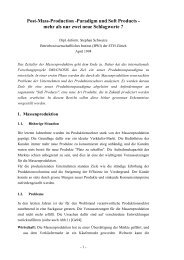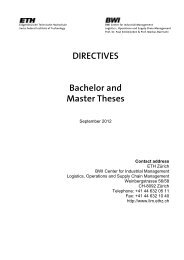The China Venture
The China Venture
The China Venture
Create successful ePaper yourself
Turn your PDF publications into a flip-book with our unique Google optimized e-Paper software.
entry strategy into the <strong>China</strong> market. Venturing successfully abroad requires preparatory<br />
measures to ensure the general fitness and compatibility of a company in relation to its<br />
partners and markets in the new environment.<br />
3.1.1 General Readiness to <strong>Venture</strong> Abroad<br />
As a first step the company should ask whether it is ready to enter the Chinese market. It has<br />
to investigate, for instance whether it has enough free management and capital resources. <strong>The</strong><br />
management time needed for a new market entry is almost more than what one expect. Due to<br />
the novelty of the venture, employees working on the market entry project will need a<br />
disproportional amount of top-level guidance and advice. Top management itself will need to<br />
travel to <strong>China</strong> to establish valuable business contacts. <strong>The</strong>se business contacts will then<br />
demand attention and time to be kept alive. It is therefore recommended that there should be<br />
one member of the top management team who is strongly dedicated to the market entry<br />
project and who is prepared to invest a substantial amount of his or her time for the project. In<br />
SMEs this high level manager with free time resources often does not exist. Such a company<br />
will therefore have to work first on internal processes to create such a capacity it will be ready<br />
to proceed to a next step.<br />
Monetary resources are important. Even if planning is done very rigorously, money invested<br />
in a high-risk emerging market like <strong>China</strong> should not be crucial to the survival of the<br />
company. <strong>The</strong>re will be ways to keep investment down to a minimum level - market entry<br />
into <strong>China</strong> does not necessarily have to be expensive - but it is very difficult to reduce risk.<br />
No amount of planning will be sufficient to account for the complexity and rapid pace of<br />
development of the market. For this reason, the company needs to be prepared to write -off its<br />
investments in the worst case scenario (see paper 8 for two examples).<br />
3.1.2 Specific Fit with the New Environment: Products and/or Partners<br />
<strong>The</strong> company's products must fit with the market conditions in <strong>China</strong>. Here, it must be<br />
assessed whether the company offers an attractive product mix for the Chinese market. <strong>The</strong><br />
level of investigation should be relatively deep as special features or mismatches might easily<br />
be overlooked. At this stage, the company will try to evaluate whether its most promising<br />
product or product category has chances to succeed in <strong>China</strong> as it is, or whether some special<br />
modification will be necessary. <strong>The</strong> degree of localisation needed may vary greatly between<br />
simple adaptations in the packaging process on the one hand, and the development of<br />
completely new features on the other hand.<br />
54






